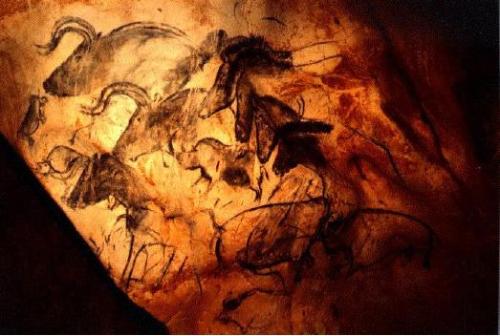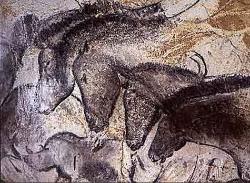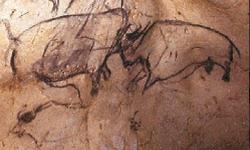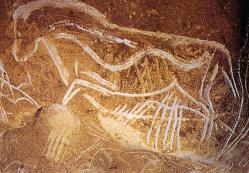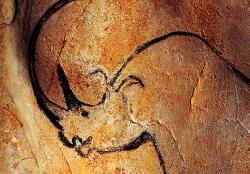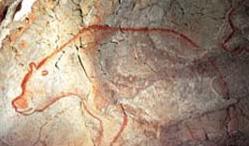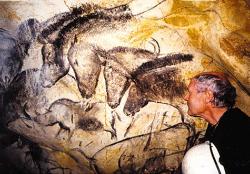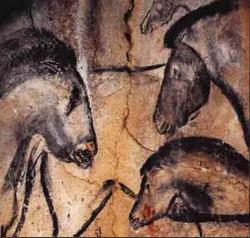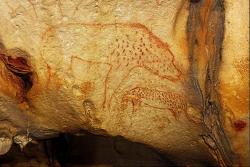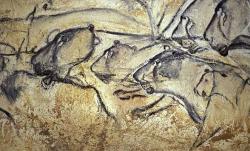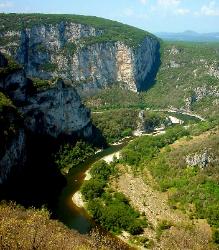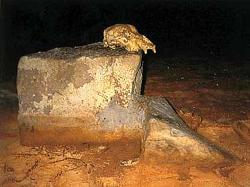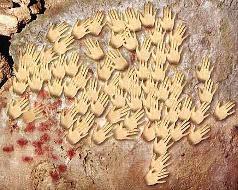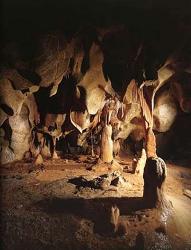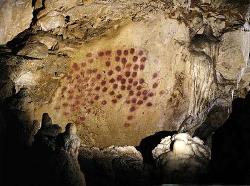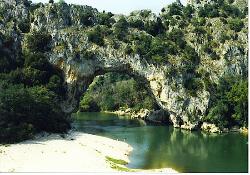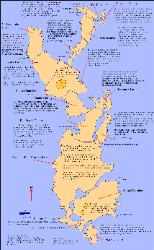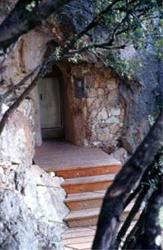| XXX |
| XXX |
| XXX |
| XXX |
| XXX |
| The left wall of the Hillaire Chamber, just before the large collapse, has many rock pendants covered with engravings. Photo: www.ancient-wisdom.co.uk/francechauvet.htm |
| XXX |
| XXXX |
| XXX |
| XXXX |
| XXX |
This discovery of the mangificent
Chauvet Cave was made in December
1994 and remains one of the most
important prehistoric sites to date. It was
found accidentally by three local cavers -
Christian Hillaire, Eliette Brunel-
Deschamps and Jean-Marie Chauvet
(after whom the cave was named). It has
recently been the subject of Werner
Herzog's new film 'Cave of Forgotten
Dreams 3D' .
The Chauvet cave is situated next to the
famous Pont d'Arc, above the old river
bed upon which the Ardèche flowed
before the archway opened up and
changed its course. It contains a vast
array and unique collection of cave
paintings dated up to 32,000 years old
making them the oldest cave paintings in
the world.
These paintings contain images of animals
such as the ibex, mammoth, giant stags,
horses, lions, bears, rhinos and even an
owl! What makes these paintings even
more extraordinary is the expressive
techniques that are used, such as the use
of perspective in the 'panel of horses'
which shows several animals on the same
plane, or with the impression of
movement shown by the duplication of
the bison's horn and hooves. The cave
was also strewn with cave bear skulls,
one of which was found placed carefully
upon a high slab as if on an alter.
John Robinson, a British sculpture and
coordinator of the Bradshaw Foundation,
was lucky enough to be allowed within
the original cave. He said about the panel
of horses that "The panel is without doubt
one of the great masterpieces of Homo
sapiens Art, besides being the oldest. I
studied the lines of black edges, and the
use of smudging to produce shadow.
Then I saw that the artist had highlighted
the outer edge of the drawing by chiseling
into the white rock surface. The incising
immediately brought to mind the wonders
of Egypt, but they were done 3,000 years
ago."
Reconsider theories
The paintings are just as complex and
artistic as the later Lascaux paintings,
which are about 10,000 years younger,
and Dr David Whitehouse (BBC online
science editor) stated that "it may indicate
that art developed much earlier than had
been realised." Charcoal used in pictures
of horses at Chauvet were analysed with
Carbon isotopes and the result "shows
that they are 30,000 years old, a
discovery that should prompt a re-think
about the development of art". This has
resulted in the reconsideration of how and
when art developed.
Helene Valladas of the Laboratory for
Climate and Environment Studies at
France's CEA-CNRS research centre at
Gif-sur-Yvette performed the analysis on
the paintings concluding that the drawings
were between 29,700 and 32,400 years
old. She says that "Prehistorians, who
have traditionally interpreted the evolution
of prehistoric art as a steady progression
from simple to more complex
representations, may have to reconsider
existing theories of the origins of art."
Pablo Picasso once said after exiting the
Lascaux caves back in 1940 that "we
have discovered nothing". This statement
is magnified when you realise that cave
Chauvet Cave was made in December
1994 and remains one of the most
important prehistoric sites to date. It was
found accidentally by three local cavers -
Christian Hillaire, Eliette Brunel-
Deschamps and Jean-Marie Chauvet
(after whom the cave was named). It has
recently been the subject of Werner
Herzog's new film 'Cave of Forgotten
Dreams 3D' .
The Chauvet cave is situated next to the
famous Pont d'Arc, above the old river
bed upon which the Ardèche flowed
before the archway opened up and
changed its course. It contains a vast
array and unique collection of cave
paintings dated up to 32,000 years old
making them the oldest cave paintings in
the world.
These paintings contain images of animals
such as the ibex, mammoth, giant stags,
horses, lions, bears, rhinos and even an
owl! What makes these paintings even
more extraordinary is the expressive
techniques that are used, such as the use
of perspective in the 'panel of horses'
which shows several animals on the same
plane, or with the impression of
movement shown by the duplication of
the bison's horn and hooves. The cave
was also strewn with cave bear skulls,
one of which was found placed carefully
upon a high slab as if on an alter.
John Robinson, a British sculpture and
coordinator of the Bradshaw Foundation,
was lucky enough to be allowed within
the original cave. He said about the panel
of horses that "The panel is without doubt
one of the great masterpieces of Homo
sapiens Art, besides being the oldest. I
studied the lines of black edges, and the
use of smudging to produce shadow.
Then I saw that the artist had highlighted
the outer edge of the drawing by chiseling
into the white rock surface. The incising
immediately brought to mind the wonders
of Egypt, but they were done 3,000 years
ago."
Reconsider theories
The paintings are just as complex and
artistic as the later Lascaux paintings,
which are about 10,000 years younger,
and Dr David Whitehouse (BBC online
science editor) stated that "it may indicate
that art developed much earlier than had
been realised." Charcoal used in pictures
of horses at Chauvet were analysed with
Carbon isotopes and the result "shows
that they are 30,000 years old, a
discovery that should prompt a re-think
about the development of art". This has
resulted in the reconsideration of how and
when art developed.
Helene Valladas of the Laboratory for
Climate and Environment Studies at
France's CEA-CNRS research centre at
Gif-sur-Yvette performed the analysis on
the paintings concluding that the drawings
were between 29,700 and 32,400 years
old. She says that "Prehistorians, who
have traditionally interpreted the evolution
of prehistoric art as a steady progression
from simple to more complex
representations, may have to reconsider
existing theories of the origins of art."
Pablo Picasso once said after exiting the
Lascaux caves back in 1940 that "we
have discovered nothing". This statement
is magnified when you realise that cave

| If you have a picture you'd like us to feature a picture in a future quiz, please email it to us at CFitzp@aol.com. If we use it, you will receive a free analysis of your picture. You will also receive a free Forensic Genealogy CD or a 10% discount towards the purchase of the Forensic Genealogy book. |
| ********** |
| ********** |

| If you enjoy our quizzes, don't forget to order our books! Click here. |
| Quiz #304 Results |
| Quiz #304 May 8, 2011 |
Answers: 1. Chauvet Cave in Southern France 2. It is the oldest known painting, thousands of years older than other cave paintings. 3. It has been sealed for tens of thousands of years. It must be protected from the outside climate, and from changes in the inside climate brought about by visitors. |
| 1. Where is this painting located? 2. What distinguishes it from similar paintings? 3. Why is access to the painting limited? Tineye Alert. You can find this picture on TinEye, but you will have more fun if you try to solve the puzzle without it. |
| ********** |
| Congratulations to Our Winners! Milene Rawlinson Daniel Jolley Joyce Veness Margreet Brouwer Robert W. Steinmann Jr. Mike Dalton Donna Jolley Dennis Brann Tish Olshefski Don Draper Carl Blessing Dorothy Nagle Ross Meunier Patricia Proskurniak Lorraine Wright Kathleen Londagin Debbie Was JoLynn Pfeiffer Evan Hindman Margaret Paxton Stephen Jolley Arthur Hartwell Jim Kiser Collier Smith James Waring Marilyn Hamill Diane Burkett |
| Comments from Our Readers |
We saw the film, “The Cave of Forgotten Dreams” in 3D the day you posted this quiz.
It was great. I am amazed that it could be done as completely when the crew was only
allowed in the cave for a total of 24 hours. One of things mentioned in the film was
that one of the painters of the art was 6 feet tall. I had not pictured Cro-Magnon man
as being that tall. {Although Jean Auel, “The Clan of the Cave Bear” series does
indicate they were :-)} Milene Rawlinson
*****
This story was in the dutch news a few days ago. I did read about it in the newspaper
and it was on the dutch television also. It is fantastic that something like this is saved
for so long time, it makes me wondering what there is to find more.
Margreet Brouwer
*****
Ah....Cool, another one of my other great interests, anthropology & archeology, first I
thought it was from Lascaux Cave until I looked at it good, then realized it was from
"that one that was only recently discovered" (this is how I file things in my brain), and
had to do some re-reading. Two of my favorite books of all time are "Art in the Ice
Age" & "The Gods of Prehistoric Man" by Dr. Johannes Maringer, a R.C. priest, who
did alot of interesting and religiously controversial writing about prehistoric cultures in
the 1940's & 1950's. The thing I always enjoyed wondering about is: Why didn't they
draw themselves?...(Someday maybe we'll find some!!!!). I always loved the hand
stencils made by mixing charcoal or red ochre & saliva, and spitting it around their
hands (sort of a like prehistoric aerosol paint can...Man, that's cool!!!!)
Robert W. Steinmann Jr.
*****
Some people with a lot more imagination than I think there are a woman's legs and
genitals amongst the various animals in the paintings...HMMMM Dennis Brann
*****
Found the time! knew they were cave paintings from my years in art history (BFA
degree), just didn't think I would have time to figure out what specifically. About all I
know of cave paintings is there are some in France so I found it pretty fast with a
search of french cave paintings. narrowed down to a couple of options and then hit
upon this one. Thanks for keeping my brain happy. Tish Olshefski
*****
I thought this would be easy -- "oh, sure, Lascaux" but trying to match the image
proved I was in the wrong place, learned a lot along the way! Fantastic!
Dorothy Nagle
*****
It was so refreshing to read that from the moment the cave was discovered until the
present day that measures have been taken to preserve the cave instead of exploiting it.
Debbie Was
*****
Great quiz... amazing paintings. Evan Hindman
It was great. I am amazed that it could be done as completely when the crew was only
allowed in the cave for a total of 24 hours. One of things mentioned in the film was
that one of the painters of the art was 6 feet tall. I had not pictured Cro-Magnon man
as being that tall. {Although Jean Auel, “The Clan of the Cave Bear” series does
indicate they were :-)} Milene Rawlinson
*****
This story was in the dutch news a few days ago. I did read about it in the newspaper
and it was on the dutch television also. It is fantastic that something like this is saved
for so long time, it makes me wondering what there is to find more.
Margreet Brouwer
*****
Ah....Cool, another one of my other great interests, anthropology & archeology, first I
thought it was from Lascaux Cave until I looked at it good, then realized it was from
"that one that was only recently discovered" (this is how I file things in my brain), and
had to do some re-reading. Two of my favorite books of all time are "Art in the Ice
Age" & "The Gods of Prehistoric Man" by Dr. Johannes Maringer, a R.C. priest, who
did alot of interesting and religiously controversial writing about prehistoric cultures in
the 1940's & 1950's. The thing I always enjoyed wondering about is: Why didn't they
draw themselves?...(Someday maybe we'll find some!!!!). I always loved the hand
stencils made by mixing charcoal or red ochre & saliva, and spitting it around their
hands (sort of a like prehistoric aerosol paint can...Man, that's cool!!!!)
Robert W. Steinmann Jr.
*****
Some people with a lot more imagination than I think there are a woman's legs and
genitals amongst the various animals in the paintings...HMMMM Dennis Brann
*****
Found the time! knew they were cave paintings from my years in art history (BFA
degree), just didn't think I would have time to figure out what specifically. About all I
know of cave paintings is there are some in France so I found it pretty fast with a
search of french cave paintings. narrowed down to a couple of options and then hit
upon this one. Thanks for keeping my brain happy. Tish Olshefski
*****
I thought this would be easy -- "oh, sure, Lascaux" but trying to match the image
proved I was in the wrong place, learned a lot along the way! Fantastic!
Dorothy Nagle
*****
It was so refreshing to read that from the moment the cave was discovered until the
present day that measures have been taken to preserve the cave instead of exploiting it.
Debbie Was
*****
Great quiz... amazing paintings. Evan Hindman
| Click on image to see larger version of panorama, or go to http://www.donsmaps.com/chauvetcave.html |
Chauvet Cave in the valley of the Ardèche River in France is filled with paintings,
engravings and drawings created more than 30 000 years ago, of cave lions,
mammoths, rhinos, bison, cave bears and horses. It contains the earliest known cave
paintings, as well as other evidence of Upper Paleolithic life. It is situated on a limestone
cliff above the former bed of the Ardèche River. The cave was first explored on
December 18, 1994. As well as the paintings, the explorers discovered fossilised
remains, prints, and markings from a variety of animals, some of which are now
extinct.
The cave is situated above the previous course of the Ardèche River followed before
the Pont d'Arc opened up. The Chauvet Cave, however, is uncharacteristically large and
the quality, quantity, and condition of the artwork found on its walls is stunning. Most
of the artwork dates to the earlier, Aurignacian, era (30 000 to 32 000 years ago). The
later Gravettian occupation, which occurred 25 000 to 27 000 years ago, left little but a
child's footprints, the charred remains of ancient hearths and carbon smoke stains from
torches that lit the caves. After the child's visit to the cave, evidence suggests that the
cave had been untouched until discovered in 1994. The footprints may be the oldest
human footprints that can be dated accurately. Near-toxic levels of carbon dioxide and
radon mean that visitors can enter the cave for only a few hours each day.
engravings and drawings created more than 30 000 years ago, of cave lions,
mammoths, rhinos, bison, cave bears and horses. It contains the earliest known cave
paintings, as well as other evidence of Upper Paleolithic life. It is situated on a limestone
cliff above the former bed of the Ardèche River. The cave was first explored on
December 18, 1994. As well as the paintings, the explorers discovered fossilised
remains, prints, and markings from a variety of animals, some of which are now
extinct.
The cave is situated above the previous course of the Ardèche River followed before
the Pont d'Arc opened up. The Chauvet Cave, however, is uncharacteristically large and
the quality, quantity, and condition of the artwork found on its walls is stunning. Most
of the artwork dates to the earlier, Aurignacian, era (30 000 to 32 000 years ago). The
later Gravettian occupation, which occurred 25 000 to 27 000 years ago, left little but a
child's footprints, the charred remains of ancient hearths and carbon smoke stains from
torches that lit the caves. After the child's visit to the cave, evidence suggests that the
cave had been untouched until discovered in 1994. The footprints may be the oldest
human footprints that can be dated accurately. Near-toxic levels of carbon dioxide and
radon mean that visitors can enter the cave for only a few hours each day.
| ********** |
| Map of cave showing galleries. www.ancient-wisdom.co.uk... |
The Grotte Chauvet is
one of hundreds of natural
caverns cut into the pale
limestone cliffs that form
the Ardeche Gorge.
The Ardèche (Occitan:
Ardecha) is a 125 km long
river in south-central
France, a right-bank
tributary of the Rhône
River. Its source is in the
Massif Central, near the
village of Astet. It flows
into the Rhône near Pont-
one of hundreds of natural
caverns cut into the pale
limestone cliffs that form
the Ardeche Gorge.
The Ardèche (Occitan:
Ardecha) is a 125 km long
river in south-central
France, a right-bank
tributary of the Rhône
River. Its source is in the
Massif Central, near the
village of Astet. It flows
into the Rhône near Pont-
Saint-Esprit, north-west of Orange. The river gives its name to the
French department of Ardèche.
The valley of the Ardèche is very scenic, in particular a 30km
section known as the Ardèche Gorges. The walls of the river here
are limestone cliffs up to 300m high. A kayak and camping trip
down the gorge is not technically difficult and hugely popular in the
summer, so much so that controlling the number of paddlers is
becoming a headache for park authorities. The most famous feature
is a natural 60m stone arch spanning the river simply known as the
Pont d'Arc (arch bridge).
www.donsmaps.com/chauvetcave.html
French department of Ardèche.
The valley of the Ardèche is very scenic, in particular a 30km
section known as the Ardèche Gorges. The walls of the river here
are limestone cliffs up to 300m high. A kayak and camping trip
down the gorge is not technically difficult and hugely popular in the
summer, so much so that controlling the number of paddlers is
becoming a headache for park authorities. The most famous feature
is a natural 60m stone arch spanning the river simply known as the
Pont d'Arc (arch bridge).
www.donsmaps.com/chauvetcave.html
| The Ardèche Gorges in France is often referred to as the 'Grand Canyon' of Europe with spectacular limestone cliffs towering up to 1000ft above the meandering river below. The entrance to |
| which is through the famous Pont D'Arc based near Vallon which at 192ft is, according to the Natural Arch and Bridge Society, "the largest natural bridge in Europe". It was here that the discovery of the Chauvet cave was made in 1994. www.ancient-wisdom.co.uk/francechauvet.htm |
| The hand prints suggest the shape of a bison or rhino. Team members Dominique Baffier and Valérie Ferrugio determined that one person, standing about five feet ten inches tall and using just the right hand to apply pigment, painted the entire panel. A computer reconstruction confirms their hypothesis. (Photos below.) |
| ********** |
| Positive hand prints, formed by coating the hand with pigment and pressing the hand on the wall. The second hand print may have been done at the same time, without recoating of the hand, as it is fainter. In the frame also are a semicircle of dots, and felines, on the "Panel of Hand Prints", in the Red Panels Gallery. www.donsmaps.com/chauvetcave.html |
| This bear skull was placed with evident care atop a slab of rock, with fragments of many more skulls on the floor nearby. From: paulsuckow.tripod.com/magatamartsalbum/id3.html |
| ********** |
| A cavebear slapped a muddy forepaw onto this image of a leopard, the first such image of a leopard known. Photo: National Geographic, August 2001 www.donsmaps.com/chauvetcave.html |
| ********** |
| The left wall of the Hillaire Chamber, just before the large collapse, has many rock pendants covered with engravings. Photo: www.ancient-wisdom.co.uk/francechauvet.htm |
| How Don Solved the Puzzle |
| My first frivolous idea was that this might be some weird tattoo on an arm - kind of craggy skin though! A better idea led me to search for “pre-historic paintings” on Google images. The first web site I viewed was www.dailycognition.com where the prehistoric paintings of 5 caves were presented. I found several photos of the Chauvet Cave wall paintings which match the paintings of the quiz. It is located in the Ardeche Valley of southeastern France. Don Draper |
| ********** |
| ********** |
| The aurochs Bos primigenius, the ancestor of domestic cattle, was a type of huge wild cattle which inhabited Europe, Asia and North Africa, but is now extinct; it survived in Europe until 1627. The aurochs were far larger than most modern domestic cattle with a shoulder height of 2 metres (6.6 ft) and weight of 1 000 kilograms (2,200 lb). The aurochs was |
| Fighting Rhinos Charcoal taken from the two fighting rhinos produced radiocarbon dates of around 31 000-32 000 BP Photo: Time Magazine 13th Feb 1995 |
regarded as a challenging hunting quarry animal, contributing to its
extinction. The last recorded aurochs, a female, died in 1627 in the
Jaktorów Forest, Poland, and her skull is now the property of the
Livrustkammaren ("Royal Armory") museum in Stockholm, Sweden.
The extinct aurochs is a completely separate species from the
still-extant wisent or European bison.
Photo:ez2www.com/go.php3?site=book&go=0810932326
extinction. The last recorded aurochs, a female, died in 1627 in the
Jaktorów Forest, Poland, and her skull is now the property of the
Livrustkammaren ("Royal Armory") museum in Stockholm, Sweden.
The extinct aurochs is a completely separate species from the
still-extant wisent or European bison.
Photo:ez2www.com/go.php3?site=book&go=0810932326
| Running Bison. The artist has shown movement by drawing extra legs. Photo: Time Magazine 13th Feb 1995 |
| The complete image includes a third cave bear following close behind. www.ancient-wisdom.co.uk/francechauvet.htm |
This superb "Panel of Horses" shows
the use of perspective with several
different animals on the same plane
John Robinson, a British sculptor and
coordinator of the Bradshaw
Foundation, said about the panel of
horses that "The panel is without
doubt one of the great masterpieces of
Homo sapiens Art, besides being the
oldest.
the use of perspective with several
different animals on the same plane
John Robinson, a British sculptor and
coordinator of the Bradshaw
Foundation, said about the panel of
horses that "The panel is without
doubt one of the great masterpieces of
Homo sapiens Art, besides being the
oldest.
I studied the lines of black edges, and the use of smudging to produce shadow.
Then I saw that the artist had highlighted the outer edge of the drawing by
chiseling into the white rock surface."
Photo: www.pma.edmonton.ab.ca/events/timetrav/iii/cave.htm
Then I saw that the artist had highlighted the outer edge of the drawing by
chiseling into the white rock surface."
Photo: www.pma.edmonton.ab.ca/events/timetrav/iii/cave.htm
| ********** |
| ********** |
| ********** |
| By painting species that virtually never wound up on the Paleolithic menu but which "symbolized danger, strength and power," says Clottes, the artists may have been attempting 'to capture the essence of' the animals. www.donsmaps.com/chauvetcave.html |
| The spectacular panel on the walls of the 'Hillaire Chamber'. The walls were smoothed before they were painted. |



